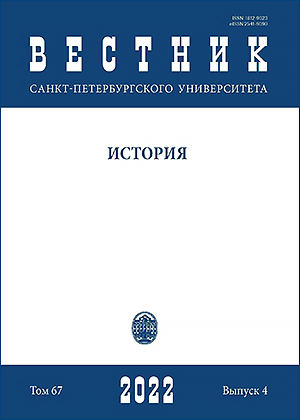Кто и как сегодня изучает русское присутствие на Южно-Маньчжурской железной дороге
DOI:
https://doi.org/10.21638/spbu02.2022.416Аннотация
На основе работ англоязычных авторов, опубликованных после 2000 г. и изучающих в том или ином ракурсе Южно-Маньчжурскую железную дорогу, автор исследует феномен российского/советского присутствия как в Маньчжурии, так и в целом в Восточной Азии. Сам объект изучения, именуемый до Русско-японской войны 1904–1905 гг. южной веткой Китайско-Восточной железной дороги, находился в ведении нашей страны непродолжительное время, однако до сих пор остается своеобразным барометром как довоенного, так и послевоенного регионального порядка. Это связано со значительным усилением Японии и японского присутствия, одним из инструментов которого была дорога и управляющая ею корпорация «Мантэцу», поэтому схема «было – стало» присутствует в заявленных исследованиях, а изменение диспозиции держав является одним из основных сюжетов. Эта же схема в ряде научных трудов отражает трансформацию позиций отдельных западных ученых под воздействием так называемых войн памяти на фоне изменений в системе международных отношений за последние 7–8 лет. Анализируемые труды концентрируются на тех сферах общественной жизни, на которые воздействовала железная дорога вне зависимости от своей подчинeнности: железнодорожная инфраструктура; русская и японская сферы интересов; транскультурный и фронтирный аспекты в связке с эмиграцией до и реэмиграцией и репатриацией после окончания Второй мировой войны; а также городское пространство трех «маркерных» поселений – Харбина, Дайрена и Чанчуня. Делается вывод о чрезвычайно малом научном внимании, уделяемом заявленной теме, о слабом использовании иностранными коллегами российских ресурсов и потенциала российских ученых, а также о конъюнктурности отдельных научных исследований, стремящихся представить нашу страну агрессором и экспансионистом, а имперскую политику – провальной для тех, кто ее разрабатывал и воплощал, а также губительной для региона.
Ключевые слова:
российское присутствие, советское присутствие, Российская империя, СССР, Япония, Китай, Маньчжурия, Южно-Маньчжурская железная дорога, Дайрен, Русско-японская война 1904–1905 гг.
Скачивания
Библиографические ссылки
Загрузки
Опубликован
Как цитировать
Выпуск
Раздел
Лицензия
Статьи журнала «Вестник Санкт-Петербургского университета. История» находятся в открытом доступе и распространяются в соответствии с условиями Лицензионного Договора с Санкт-Петербургским государственным университетом, который бесплатно предоставляет авторам неограниченное распространение и самостоятельное архивирование.





